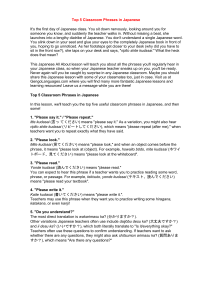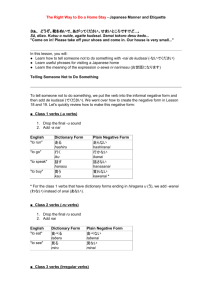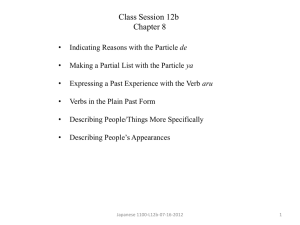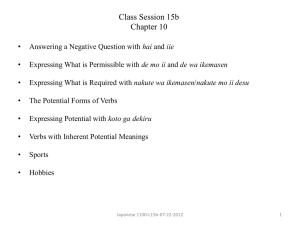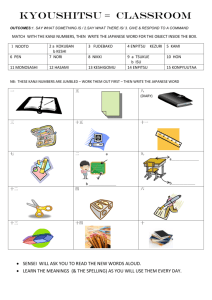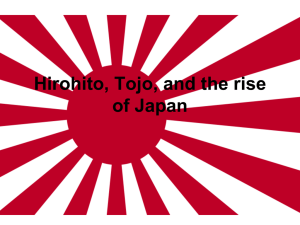Class Session 14a Lecture (7/19/12)
advertisement
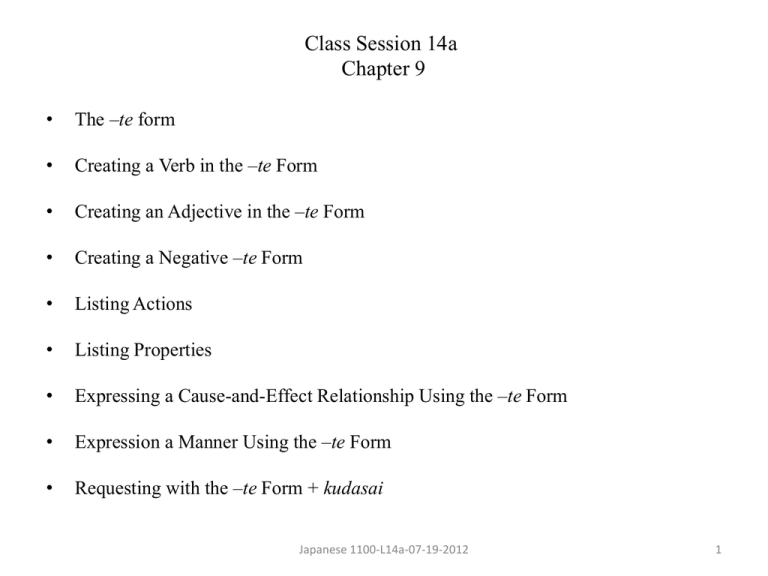
Class Session 14a Chapter 9 • The –te form • Creating a Verb in the –te Form • Creating an Adjective in the –te Form • Creating a Negative –te Form • Listing Actions • Listing Properties • Expressing a Cause-and-Effect Relationship Using the –te Form • Expression a Manner Using the –te Form • Requesting with the –te Form + kudasai Japanese 1100-L14a-07-19-2012 1 The –te form - Verbs • Verbs and adjectives in the te-form1 end in te or de as in tabete (eat) , nonde (drink), takakute (expensive), kirei de (pretty) and gakusei de (student) • Basic function of the te-form is to show the verb or adjective is followed by an additional verb or adjective in the same sentence, representing a meaning like do something, and . . . or to be someway/something and . . . • All the verbs in this sentence are in the te-form except the last verb; the time of action is indicated by the final verb: kinō wa, bangohan o tabete, terebi o mite, nemashita. Yesterday, I ate supper, watched TV, and went to bed. • The time of action in these sentences is the future: kyō wa, bangohan o tabete, terebi o mite, nemasu. Today, I will eat supper, watch TV, and go to bed. -------------------------------1 Sometimes also called the “connective form” Japanese 1100-L14a-07-19-2012 2 The –te form - Adjectives • The same logic applies to adjectives in the te-form: yamada-san wa atama go yokute, kirei de, yasashii desu. Ms. Yamada is smart, pretty, and kind. kyonen no nihon-go no kurasu wa shukudai ga ookute, tesuto ga muzukashikute, taihen deshita. Last year’s Japanese class had a lot of homework and difficult tests, and it was a lot of work. Japanese 1100-L14a-07-19-2012 3 Creating a Verb in the –te Form To create a verb in the te-form from the plain past affirmative form, change the final syllable from ta and da to te and de respectively: Verb Plain Past Affirmative te-form taberu (to eat) tabeta tabete iku (to go) itta itte hanasu (to speak) hanashita hanashite nomu (to drink) nonda nonde Japanese 1100-L14a-07-19-2012 4 Creating an Adjective in the –te Form • The te-form of an i-adjective is created by adding kute to the end of the stem: takai taka taka-kute • The te-form of a na-adjective is created by adding de at the end of the stem: kirei na kirei kirei de • The adjective ii (from yoi) is slightly irregular; its te-form is yo-kute Japanese 1100-L14a-07-19-2012 5 Creating a Negative –te Form - Verbs • You can form verbs and adjectives in the negative te-form by replacing the i at the end of the plain negative form with kute; that is you treat the plain negative form as an adjective: Plain Present Negative Form Negative te form tabenai tabenakute takakunai takakunakute shizuka ja nai shizuka ja nakute gakusei ja nai gakusei ja nakute Examples: haha ga konakute, komarimashita. My mother did not come, and I was upset. takakunakute, oishikute, totemo ii desu. It is not expensive, but it is delicious and very good. Japanese 1100-L14a-07-19-2012 6 Listing Actions • You can list multiple events and actions using the te-form; all verbs except the last one should be in the te-form. • This construction implies sequence; the two sentences below are not the same: kinō no ban wa, shukudai o shite, terebi o mimashita. Last night, I did homework and watched television. kinō no ban wa, terebi o mimashite, shukudai o shimashita. Last night, I watched television, and did homework. • If two separate sentences are preferable, you can relate them with the conjunction sore kara: kino no ban wa terebi o mimashita. Sore kara, shukudai o shimashita. Last night, I watched television. Then I did homework. Japanese 1100-L14a-07-19-2012 7 Listing Actions • When a negative te-form is used in this construction, it can be interpreted as either Do not do . . . And or without doing . . . basu ni noranai de, takushii ni norimashita. I did not take a bus, I took a taxi. asa-gohan o tabenai de, gakkō ni ikimashita. I went to school without eating breakfast. jisho o tsukawanai de nihon-go no tegami o kakimashita. I wrote a letter in Japanese without using a dictionary. o-kane o karinai de, ie o kaimashita. I bought a house without borrowing money. Japanese 1100-L14a-07-19-2012 8 Listing Properties • You can list properties of a person or thing using adjectives in the te-form. • The last adjective in a series is in the regular form representing the correct tense: yamada-san wa kirei de, yasashii desu. Ms. Yamada is pretty and kind. ano resutoran wa mazukute, kitanai desu. That restaurant is not delicious and (it is) dirty. ano kurasu wa testuto ga ookunakute, yokatta desu. that class did not have many tests, and it was great. Japanese 1100-L14a-07-19-2012 9 Expressing a Cause-and-Effect Relationship Using the –te Form • Depending on context, a phrase with a te-form can express the cause of the event or state: nebō shite, kurasu ni okuremashita. I overslept, and (as a result) I was late for the class. hataraite, tsukaremashita. I worked, and (as a result) I got tired. shigoto ga kirai de, kaisha o yamemashita. I hated the work, and (as a result) I quit the company. kinō no tesuto wa muzukashikute, wakarimasen deshita. Yesterday’s test was difficult, and (as a result) I did not understand it. kaze o hiite, kurasu oyasumimashita. I caught a cold and missed the class. nihon-go no sensei wa daigakuin no gakusei de, amari kibishiku arimasen. The Japanese teacher is a graduate student and is not very strict. Japanese 1100-L14a-07-19-2012 10 Expressing a Manner Using the –te Form • Manner or means can be expressed for an action using the te-form: aruite daigaku ni ikimasu. I walk to school. CD o kiite, renshū shimashō. Let’s practice by listening to a (this) CD. Japanese 1100-L14a-07-19-2012 11 Requesting with the –te Form + kudasai • To request someone to do something, use the verb in the te-form and kudasai (which is derived from kudasaru, give to me/us) • tatte kudasai (from tatsu, to stand up) means something like “stand up, and give it to me as a service or favor,” but actually means “Please stand up” nonde kudasai. Please drink (it). yonde kudasai. Please read (it). • To request someone not do something, use the negative te-form: tatanai de kudasai. Please do not stand. nomanai de kudasai. Please do not drink (it). • To make the request more polite, add masen ka to the end: tate kudasaimasen ka. Please stand (polite). tatanai de kudasaimasen ka. Please do not stand (polite). Japanese 1100-L14a-07-19-2012 12
